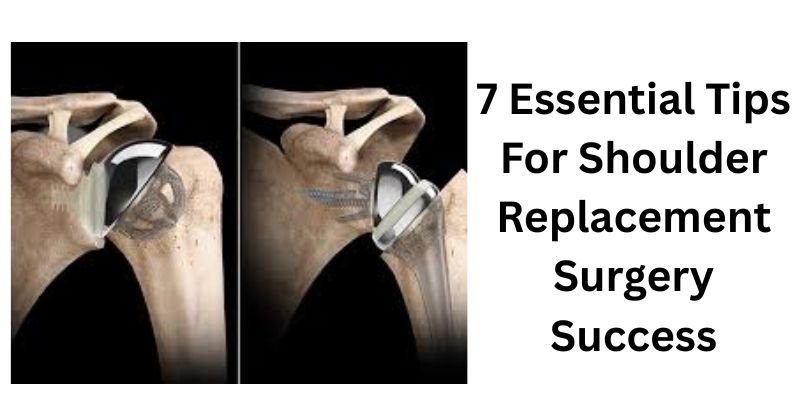Shoulder replacement surgery, or shoulder arthroplasty, is a life-changing procedure for people suffering from severe shoulder pain, often due to arthritis, rotator cuff injuries, or other degenerative conditions. If you’ve been advised to undergo this surgery, you might be wondering about the shoulder replacement surgery success rate and how to ensure a smooth recovery. With the right mindset, preparation, and post-surgery care, you can maximize the benefits of this surgery and return to a more active lifestyle.
Here are seven essential tips to help ensure successful shoulder replacement surgery:
1. Understand the Surgery and What to Expect
Before undergoing shoulder replacement surgery, it’s essential to understand the procedure and what it involves. The surgery typically involves removing damaged parts of the shoulder joint and replacing them with artificial components made of metal, plastic, or ceramic. You should ask your surgeon questions about the type of prosthesis, the expected outcomes, and the recovery process. Understanding these details can help reduce anxiety and set realistic expectations for your recovery.
The shoulder replacement surgery success rate is generally high, with most patients experiencing significant improvements in pain relief and joint function. However, being informed about the surgery and discussing your concerns with your surgeon can further improve your outcome.
2. Prepare Physically for Surgery
In the weeks leading up to surgery, focus on preparing your body for the procedure. Maintaining a healthy weight, staying physically active, and performing strengthening exercises (as recommended by your surgeon or physical therapist) will give your body the best chance to recover quickly. If you are a smoker, quitting before the surgery can help improve circulation and reduce the risk of complications.
You should also ensure that your home environment is ready for your post-surgery needs. This includes setting up a comfortable resting area, removing tripping hazards, and securing items that may be difficult to reach or use after surgery.
3. Follow Pre-Surgery Instructions Carefully
Your surgeon will provide you with specific pre-surgery instructions. This might include fasting before surgery, adjusting your medications, or avoiding certain activities. It’s critical to follow these instructions to ensure the best possible outcome. For instance, taking the right antibiotics to reduce the risk of infection and discontinuing medications that could affect bleeding or anesthesia is crucial.
Failure to follow pre-surgery guidelines could lead to complications or delays in your recovery. Make sure to ask your medical team about any concerns or instructions you don’t fully understand.
4. Engage in Post-Surgery Physical Therapy
One of the most important aspects of a successful recovery after shoulder replacement surgery is physical therapy. Shoulder replacement recovery is a gradual process that requires commitment to rehabilitation. After surgery, your surgeon will likely recommend a structured physical therapy program to help you regain strength, flexibility, and range of motion in your shoulder.
Physical therapy will likely begin within the first few days after surgery, and early engagement is key to recovery. Follow the therapist’s guidance carefully, and don’t push yourself too hard. Over time, you’ll build the strength and mobility necessary to resume regular activities.
5. Manage Pain Effectively
Pain management is a critical part of the recovery process. Right after surgery, you will likely experience some pain, but this can be managed effectively with medications and other strategies. Your surgeon or healthcare team will provide a pain management plan tailored to your needs, which may include a combination of prescription painkillers, ice packs, and physical therapy.
It’s essential to take your medications as prescribed and avoid taking too many painkillers in an attempt to rush the healing process. Overusing pain medications can lead to complications and delay recovery.
6. Be Patient and Set Realistic Expectations
While shoulder replacement surgery success rates are high, every person’s recovery experience is unique. It’s important to be patient with yourself and understand that it may take time to return to full function. Initial recovery might involve swelling, bruising, and some discomfort, but these are temporary and will improve as you heal.
Your surgeon will guide you on what to expect throughout the recovery timeline, but it’s vital to avoid rushing the process. Listen to your body, follow your doctor’s advice, and don’t expect to return to full activity immediately. Remember, a successful outcome is built on gradual progress, not pushing through the pain.
7. Follow Long-Term Maintenance Guidelines
Once you’ve made it through the initial recovery phase, it’s important to continue practicing good shoulder health habits. Regularly performing exercises that strengthen the shoulder muscles and maintain joint flexibility will help keep the new shoulder functioning well for many years. Be mindful of activities that put excessive strain on the shoulder, and avoid heavy lifting or high-impact movements without your surgeon’s approval.
Additionally, attending follow-up appointments with your surgeon will help monitor your shoulder’s progress and detect any potential issues early on. Many patients find that they can return to normal daily activities, including driving, lifting light objects, and participating in recreational activities like swimming or tennis.
Final Thoughts
In conclusion, shoulder replacement surgery can significantly improve your quality of life, alleviating chronic pain and restoring function to a severely damaged shoulder. By following the above tips, you can ensure a successful recovery and improve your chances of achieving a high shoulder replacement surgery success rate. Remember to follow your surgeon’s advice, be patient with your recovery, and engage in physical therapy to maximize the benefits of your new shoulder. With time and proper care, you’ll be able to enjoy an active and pain-free lifestyle once again.
for more(click here)










 Stronger Erections: Ideal for men with moderate to severe ED.
Stronger Erections: Ideal for men with moderate to severe ED.  Recommended Dose: One tablet (150 mg) taken 30–60 minutes before sexual activity.
Recommended Dose: One tablet (150 mg) taken 30–60 minutes before sexual activity.  With Water: Swallow whole with a glass of water. Do not chew or crush.
With Water: Swallow whole with a glass of water. Do not chew or crush.  Empty Stomach Preferred: Taking it on an empty stomach speeds up absorption.
Empty Stomach Preferred: Taking it on an empty stomach speeds up absorption.  Do Not Overdose: Only one dose per 24 hours. Avoid consuming alcohol or fatty meals before taking Cenforce 150, as these can delay or reduce its effectiveness. Possible Side Effects Like any medication, Cenforce 150 can cause side effects, especially when not used properly or without medical supervision. Common side effects include: Headache Flushing Dizziness Nasal congestion Upset stomach Blurred vision Seek immediate medical help if you experience severe side effects such as chest pain, irregular heartbeat, or an erection lasting more than 4 hours (priapism). Warnings and Precautions Before taking Cenforce 150, keep these precautions in mind:
Do Not Overdose: Only one dose per 24 hours. Avoid consuming alcohol or fatty meals before taking Cenforce 150, as these can delay or reduce its effectiveness. Possible Side Effects Like any medication, Cenforce 150 can cause side effects, especially when not used properly or without medical supervision. Common side effects include: Headache Flushing Dizziness Nasal congestion Upset stomach Blurred vision Seek immediate medical help if you experience severe side effects such as chest pain, irregular heartbeat, or an erection lasting more than 4 hours (priapism). Warnings and Precautions Before taking Cenforce 150, keep these precautions in mind:  Do not take with nitrates or heart medications.
Do not take with nitrates or heart medications.  Not suitable for men with certain medical conditions (e.g., severe heart or liver issues).
Not suitable for men with certain medical conditions (e.g., severe heart or liver issues).